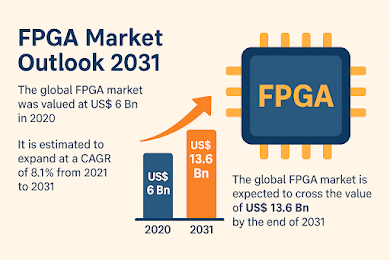Field-Programmable Gate Array Market Doubles by 2031 on High-Tech Demand
The global field-programmable
gate array (FPGA) market, valued at US$ 6 Bn in 2020, is poised for
robust growth. According to market projections, the FPGA market is expected to
expand at a CAGR of 8.1% from 2021 to 2031, reaching US$ 13.6 Bn by
the end of 2031. This growth is attributed to the surge in data center
deployments, advancements in 5G infrastructure, and the growing use of FPGA in
diverse sectors including automotive, aerospace, and telecommunications.
Market Overview: FPGAs are integrated circuits that
can be configured post-manufacturing, making them highly flexible and suitable
for a variety of applications such as video/image processing, industrial
automation, and Big Data analytics. Their reprogrammable nature and compact
design allow for rapid innovation and product adaptation. FPGAs play a critical
role in supporting high-performance computing systems, which are becoming
integral to industries across the globe.
Market Drivers & Trends
The primary drivers fueling the growth of the FPGA market
include:
- Rising
demand for data centers to handle massive volumes of real-time
information generated by IoT devices.
- Adoption
of 5G networks, requiring sophisticated RF signal processing and data
transmission capabilities.
- Integration
in automotive systems, especially in advanced driver-assistance
systems (ADAS), infotainment, and safety applications.
- Increased
investment in industrial automation, consumer electronics, and
military applications.
A major trend reshaping the market is the shift toward SRAM-based
FPGA devices, which offer superior reconfiguration capabilities and are
preferred for high-reliability applications in aerospace and communications.
Latest Market Trends
- FPGA
in 5G Infrastructure: Modern 5G NR base stations utilize FPGAs for
high-speed data routing and processing. For instance, Xilinx’s Zynq
UltraScale+ RFSoC is tailored to support remote radio heads and backhaul
systems.
- Rise
of AI and ML Applications: The reprogrammability of FPGAs makes them
suitable for evolving AI workloads, where data paths need constant updates
for optimization.
- Edge
Computing: Deployment of edge computing systems is increasing demand
for low-latency, high-throughput FPGA components.
Key Players and Industry Leaders
Several global companies are at the forefront of the FPGA
market. Notable names include:
- Xilinx,
Inc.
- Intel
Corporation
- Microchip
Technology Inc.
- Lattice
Semiconductor Corporation
- QuickLogic
Corporation
- Efinix
Inc.
- GOWIN
Semiconductor Corporation
- Achronix
Semiconductor Corporation
- Microsemi
Corporation
These companies are driving innovation through continuous
R&D, strategic acquisitions, and product launches.
Recent Developments
- Lattice
Semiconductor introduced the Lattice Mach-NX FPGA in December
2020, aimed at secure control applications in industrial, computing, and
automotive sectors.
- Microchip
Technology Inc. launched PolarFire SoC, a RISC-V-based FPGA, to
serve power-sensitive applications.
- Xilinx
Inc. unveiled Kintex Ultrascale XQRKU060 FPGA targeting
space-grade computing applications.
Download Sample PDF
Copy Now: https://www.transparencymarketresearch.com/sample/sample.php?flag=S&rep_id=1405
Market Opportunities
- Post-pandemic
recovery has revealed new opportunities in healthcare,
telecommunications, and automotive electronics where FPGA use is surging.
- 5G
and IoT proliferation provide long-term opportunities for FPGA makers
to embed their solutions in real-time data processing and communications
infrastructure.
- Automotive
applications such as electric vehicles and autonomous driving systems
are expected to increasingly rely on FPGA for system control and
processing.
Future Outlook
Over the next decade, the FPGA market is expected to
witness:
- Greater
diversification into new industries, including renewable energy and
smart grids.
- Widespread
adoption in defense systems, especially in avionics, radar, and
secure communication platforms.
- Increase
in cloud-based FPGA solutions offering scalable and on-demand FPGA
compute resources.
The high demand from data-intensive sectors, combined with
the benefits of FPGA’s flexibility and efficiency, positions the technology as
a critical enabler of future digital transformation.
Market Segmentation
By Configuration
- Low-end
FPGA
- Mid-range
FPGA
- High-end
FPGA
By Node Size
- ≤28 nm
- 28–90
nm
- 90 nm
By Architecture
- SRAM-based
FPGA
- Anti-fuse-based
FPGA
- Flash-based
FPGA
By End-use Industry
- Consumer
Electronics
- IT
& Telecommunication
- Aerospace
& Defense
- Industrial
- Others
(Automotive & Transportation, Healthcare)
Regional Insights
Asia Pacific is the fastest-growing region in the
FPGA market, led by countries such as China, Japan, and India. These
nations are witnessing rapid growth in data center construction, consumer
electronics manufacturing, and 5G deployments.
North America, led by the U.S., remains a key hub due
to a mature technology ecosystem and high investment in defense and automotive
industries.
Europe is expected to maintain steady growth,
particularly in automotive and industrial automation sectors, while South
America and the Middle East & Africa are gradually emerging with
growing ICT infrastructures and government investments.
Why Buy This Report?
- Provides
in-depth analysis of market dynamics, including drivers,
restraints, and opportunities.
- Includes
regional and segment-wise insights to support strategic
decision-making.
- Features
competitive landscape and profiling of key players with their
latest strategies and innovations.
- Offers
forecast data up to 2031, helping businesses plan long-term strategies.
- Covers
emerging trends and technologies shaping the FPGA landscape.
Frequently Asked Questions
1. What is the current size of the global FPGA market?
As of 2020, the market was valued at US$ 6 Bn.
2. What is the projected value of the FPGA market by
2031?
The FPGA market is expected to reach US$ 13.6 Bn by the end of 2031.
3. What is driving the growth of the FPGA market?
The market is driven by data center expansion, 5G infrastructure development,
increasing applications in automotive and aerospace sectors, and advancements
in AI and IoT.
4. Who are the major players in the FPGA market?
Key players include Xilinx, Intel, Microchip Technology, Lattice
Semiconductor, Efinix, and QuickLogic.
5. Which region is expected to grow the fastest?
Asia Pacific, due to rapid industrialization, growing consumer demand,
and robust 5G deployment.
6. What are the major end-use industries?
Consumer electronics, IT & telecom, aerospace & defense, industrial
automation, automotive, and healthcare.





0 comments:
Post a Comment